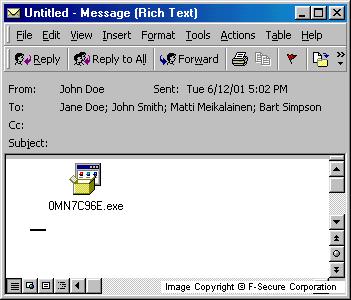Hadra
Summary
This is Internet worm spreading with emails being attached as EXE file. The worm itself is Win32 executable file about 12Kb of length, written in VisualBasic. The worm code is compressed with UPX Win32 EXE files compression utility, and being unpacked it gets about 26Kb of size.
Removal
Based on the settings of your F-Secure security product, it will either move the file to the quarantine where it cannot spread or cause harm, or remove it.
A False Positive is when a file is incorrectly detected as harmful, usually because its code or behavior resembles known harmful programs. A False Positive will usually be fixed in a subsequent database update without any action needed on your part. If you wish, you may also:
-
Check for the latest database updates
First check if your F-Secure security program is using the latest updates, then try scanning the file again.
-
Submit a sample
After checking, if you still believe the file is incorrectly detected, you can submit a sample of it for re-analysis.
Note: If the file was moved to quarantine, you need to collect the file from quarantine before you can submit it.
-
Exclude a file from further scanning
If you are certain that the file is safe and want to continue using it, you can exclude it from further scanning by the F-Secure security product.
Note: You need administrative rights to change the settings.
Technical Details
When the worm starts (when a user clicks on attached EXE file) the worm copies itself to Windows directory with MSSERV.EXE name and registers that file in Windows registry auto-run keys:
HKEY_CURRENT_USER\Software\Microsoft\Windows\CurrentVersion\Run HKEY_CURRENT_USER\Software\Microsoft\Windows\CurrentVersion\RunServices HKEY_LOCAL_MACHINE\Software\Microsoft\Windows\CurrentVersion\Run HKEY_LOCAL_MACHINE\Software\Microsoft\Windows\CurrentVersion\RunServices
All these "Run=" keys then have the string value that runs worm copy on each Windows start:
- msservice = %WinDir%\msserv.exe
where %WinDir% is Windows main directory.
Spreading
The worm then stays in Windows memory as hidden application (service), connects to MS Outlook and registers itself as MS Outlook "NewMail" and "ItemSend" events handler (i.e. the worm attaches itself to MS Outlook events).

On "NewMail" (a new mail has arrived) the worm looks if it is its own message from another infected machine, and then deletes it. The worm opens the message, looks for EXE attach and deletes that message if EXE attach has the same length as worm's EXE file has.
On "ItemSend" (a message is being sent) the worm looks for already attached files, gets the first one, replaces it with its own copy, renames attach to .EXE, and then sends it. If the message has no attach, the worm attaches itself with eight bytes random name and .EXE extenstion.
On Friday 13th from 13:00 till 14:00 the worm also adds the text to the beginning of message body:
[I-Worm.Hydra] ...by gl_st0rm of [mions]
Protection
The worm performs several actions to hide itself and to avoid removing its file and affected registry "Run=" keys. The worm deletes the MSCONFIG.EXE file in Windows system directory, looks for active applications and kills them (terminates these processes):
- "AVP Monitor"
- "AntiVir"
- "Vshwin"
- "F-STOPW"
- "F-Secure"
- "vettray"
- "InoculateIT"
- "Norman Virus Control"
- "navpw32"
- "Norton AntiVirus"
- "Iomon98"
- "AVG"
- "NOD32"
- "Dr.Web"
- "Amon"
- "Trend PC-cillin"
- "File Monitor"
- "Registry Monitor"
- "Registry Editor"
- "Task Manager"
As a result the worm disables several types of anti-virus protections, as well as immediately closes Registry editors on their start.
The worm also try to kill F-Secure Anti-Virus and AVP anti-virus databases.
Member of SETI Distributed Network
The worm installs and activates the SETI (Search for Extraterrestrial Intelligence) software to affected computer (see more information about SETI at https://setiathome.berkeley.edu).
The SETI software is downloaded by worm to Windows directory with MSSETI.EXE name from following FTP sites:
ftp://ftp.cdrom.com/pub/setiathome/setiathome-3.03.i386-winnt-cmdline.exe ftp://ftp.let.uu.nl/pub/software/winnt/setiathome-3.03.i386-winnt-cmdline.exe ftp://ftp.cdrom.com/.2/setiathome/setiathome-3.03.i386-winnt-cmdline.exe ftp://alien.ssl.berkeley.edu/pub/setiathome-3.03.i386-winnt-cmdline.exe ftp://setidata.ssl.berkeley.edu/pub/setiathome-3.03.i386-winnt-cmdline.exe
The worm also creates in Windows directory the following files:
- USER_INFO.SAH and VERSION.SAH with SETI specific information
- MSSETI.PIF, RUN_MSSETI.VBS, MSSETI.BAT to run SETI program
and registers RUN_MSSETI.VBS file in Registry auto-run keys:
HKEY_LOCAL_MACHINE\Software\Microsoft\Windows\CurrentVersion\Run msseti = WScript.exe %WinDir%\run_msseti.vbs" HKEY_LOCAL_MACHINE\Software\Microsoft\Windows\CurrentVersion\RunServices msseti = WScript.exe %WinDir%\run_msseti.vbs"
The USER_INFO.SAH file contains user specific information about SETI user, the worm writes following IDs to there:
id=2199938 key=1603033966 email_addr=gl_storm@seznam.cz name=GL_STORM country=Czech Republic